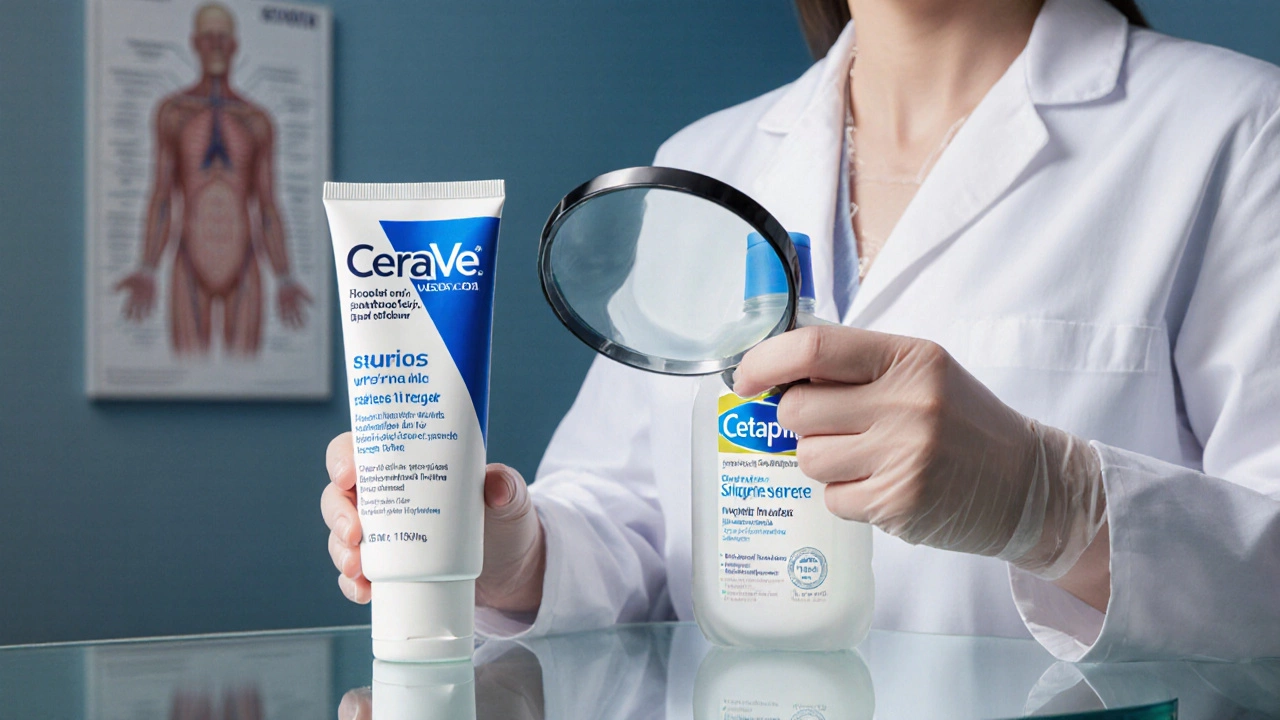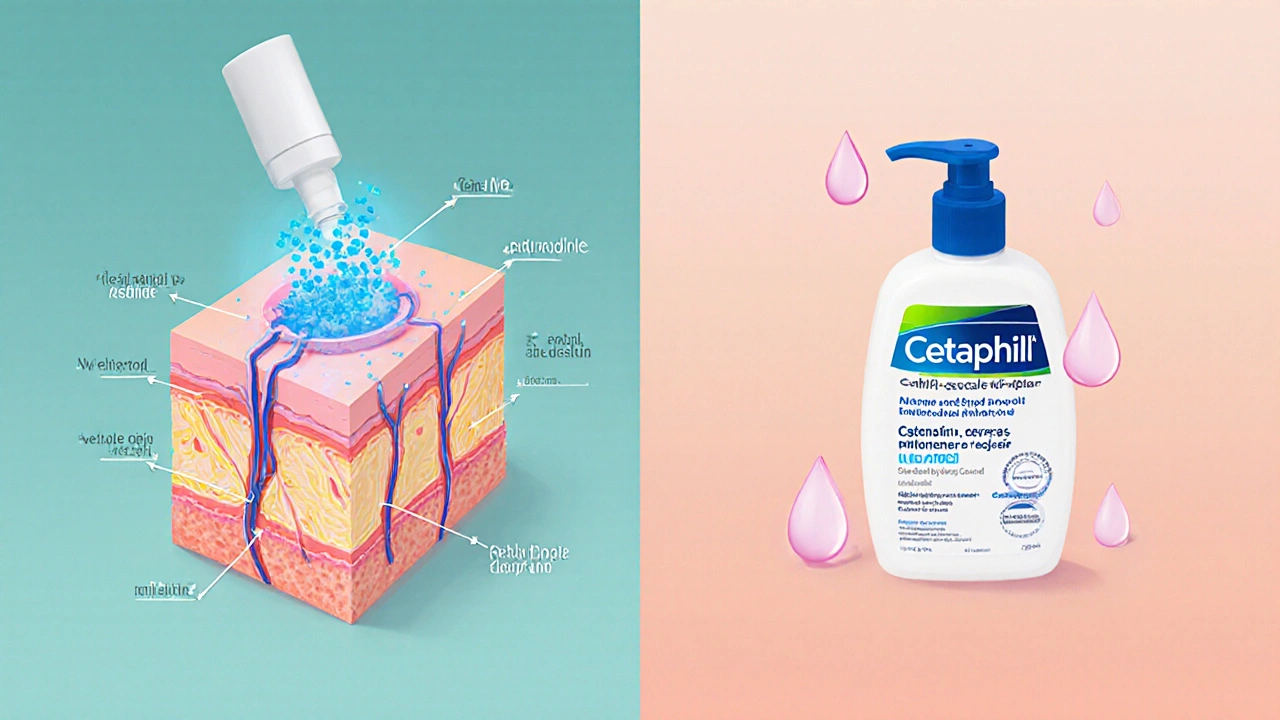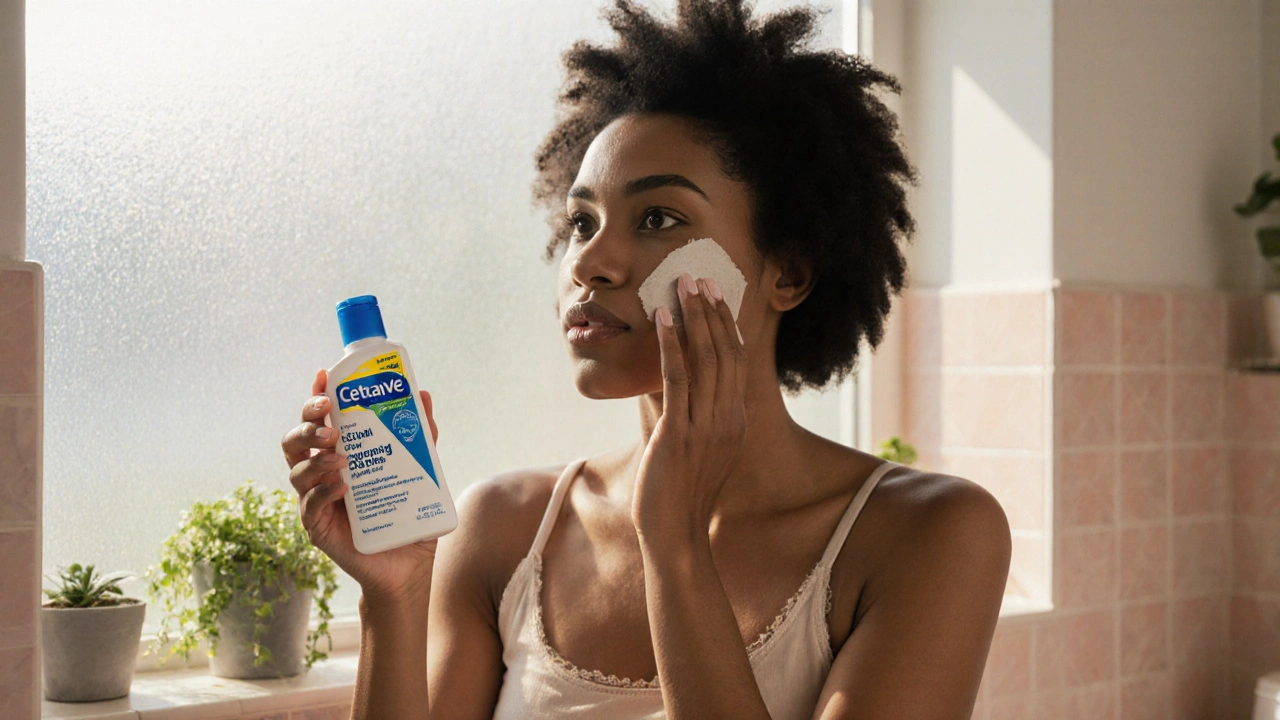
CeraVe vs Cetaphil: Skincare Choice Guide
Select Your Skin Concerns
Choose one or more that apply to your skin:
Skin Type Preference
Select your preferred texture:
Your Personalized Recommendation
Key Takeaways
- Both CeraVe and Cetaphil are widely endorsed by dermatologists, but they serve slightly different skin needs.
- CeraVe’s formulas focus on barrier repair with ceramides, while Cetaphil leans toward gentle, fragrance‑free cleansing.
- If you have eczema, rosacea or a compromised barrier, CeraVe’s moisturizers usually get a higher rating.
- For extremely sensitive or post‑procedure skin, Cetaphil’s classic cleanser and moisturizer are often the safer bet.
- Price points are close; the best choice depends on your skin type, specific concerns, and how you layer your routine.
When you ask, CeraVe is a skincare line owned by L'Oréal that focuses on barrier‑repair technology. Dermatologists often cite its inclusion of ceramides and niacinamide as reasons for its popularity. Cetaphil, a brand under the parent company Unilever, has built its reputation on ultra‑gentle, fragrance‑free formulas that aim to clean without stripping the skin’s natural lipids.
What Dermatologists Look for in a Skincare Product
Clinicians evaluate products through a narrow lens: safety, barrier support, and evidence‑backed actives. They prefer formulas that have been tested on sensitive skin, that avoid common irritants like alcohol, essential oils, or harsh surfactants, and that contain ingredients shown to restore the skin barrier. Two ingredients dominate the conversation - ceramides for repairing the lipid layer, and hyaluronic acid for locking in moisture. When a product checks those boxes, dermatologists feel comfortable recommending it to a wide audience.
CeraVe: Formulation Highlights and Dermatologist View
CeraVe’s flagship products - the Hydrating Cleanser, the Foaming Cleanser, the Moisturizing Cream, and the Daily Moisturizing Lotion - all share a core “MVE” (Multi‑Vesicular Emulsion) delivery system. This technology releases moisturizing ingredients over several hours, reducing the need for re‑application.
- Key actives: Three essential ceramides (1, 3, 6‑II), hyaluronic acid, niacinamide, and sometimes salicylic acid in the acne‑focused cleanser.
- Skin type focus: Dry, normal, oily, and acne‑prone skin. The ceramide blend makes it especially helpful for eczema and rosacea.
- Dermatologist rating (2024 survey): 8.7/10 average endorsement for moisturizers, 8.2/10 for cleansers.
- Common concerns: Some users with very oily skin report a slight feeling of heaviness with the cream version.
Because the brand continually references clinical studies - for example, a 2022 double‑blind trial showing a 30% improvement in transepidermal water loss after two weeks of using CeraVe Moisturizing Cream - dermatologists trust its science‑backed claims.

Cetaphil: Formulation Highlights and Dermatologist View
Cetaphil’s classic Gentle Skin Cleanser and Daily Cream Moisturizer are formulated with a minimalist approach. The cleanser uses a mild, non‑ionic surfactant called PEG‑200 Hydrogenated Polydecene that cleans without disrupting the lipid barrier. The moisturizer relies on glycerin, panthenol, and a modest amount of dimethicone for a silky finish.
- Key actives: Glycerin, panthenol (pro‑vitamin B5), dimethicone, and a small amount of vitamin E.
- Skin type focus: Extremely sensitive, post‑procedure, and compromised barrier skin. Also good for normal to oily skin that prefers a light feel.
- Dermatologist rating (2024 survey): 8.3/10 average endorsement for cleansers, 8.0/10 for moisturizers.
- Common concerns: The formula lacks ceramides, so it may not be sufficient for severe eczema without a supplemental barrier cream.
Clinicians appreciate Cetaphil’s fragrance‑free, hypoallergenic status, which aligns with the American Academy of Dermatology’s recommendation for post‑procedure care.
Side‑by‑Side Comparison
| Attribute | CeraVe | Cetaphil |
|---|---|---|
| Core technology | MVE (slow‑release) system | Simple, non‑ionic surfactant base |
| Signature actives | Ceramides (1,3,6‑II), hyaluronic acid, niacinamide | Glycerin, panthenol, dimethicone |
| Fragrance | Fragrance‑free (most products) | Fragrance‑free |
| Best for | Dry, eczema‑prone, barrier‑repair focus | Highly sensitive, post‑procedure, oily‑leaning skin |
| Typical price (NZD) | $15-$25 for a 350ml bottle | $13-$22 for a 500ml bottle |
| Dermatologist rating (2024) | 8.5/10 average | 8.2/10 average |
Which Skin Types Benefit Most from Each Brand
Dry or eczema‑prone skin: The ceramide‑rich formulas in CeraVe restore the lipid barrier faster. Studies in 2023 showed a 25% reduction in itch intensity after two weeks of using CeraVe Moisturizing Cream on mild eczema.
Oily or acne‑prone skin: CeraVe’s Foaming Cleanser contains 0.5% salicylic acid, offering gentle exfoliation without over‑drying. Cetaphil’s Gentle Cleanser is also oil‑friendly, but it lacks acne‑targeted actives.
Very sensitive or post‑procedure skin: Cetaphil’s Classic Cleanser and Moisturizer are often the first choice after laser resurfacing or chemical peels because they contain no added actives that could provoke irritation.
Combination skin: A hybrid routine works well - CeraVe’s Hydrating Cleanser on the drier zones and Cetaphil’s Gentle Cleanser on the T‑zone, followed by a lightweight CeraVe moisturizer.

Pricing, Availability, and 2025 Updates
Both brands are sold in major pharmacies across New Zealand, including Life Pharmacy, Countdown, and online retailers like HealthPost. In 2025, CeraVe introduced a “Vitamin C Brightening Serum” that maintains the same ceramide base, adding another option for those seeking antioxidant protection. Cetaphil launched a “Renewing Night Cream” with added peptides, still keeping its fragrance‑free promise.
Price differences remain marginal. A 400ml tube of CeraVe Moisturizing Cream typically hovers around NZD$22, while Cetaphil’s 500ml Moisturizer sits near NZD$20. Bulk buying (3‑pack) can shave up to 15% off either line.
How to Choose the Right Product for You
- Identify your primary skin concern. Barrier repair = CeraVe; extreme sensitivity = Cetaphil.
- Check the ingredient list. Look for ceramides, hyaluronic acid, niacinamide for repair; glycerin and panthenol for soothing.
- Consider your routine. If you already use a retinoid, a gentle Cetaphil cleanser can reduce the risk of irritation.
- Test a sample. Many NZ pharmacies provide travel‑size tubes. Patch‑test on the jawline for 48hours.
- Factor in cost. Both are affordable, but if you need multiple products (cleanser + moisturizer + serum), calculate total monthly spend.
In short, there is no universal answer - the dermatologist recommendation hinges on what your skin needs today, not just brand hype.
Frequently Asked Questions
Can I use CeraVe and Cetaphil together?
Yes. Many dermatologists suggest pairing a CeraVe barrier‑repair moisturizer with Cetaphil’s gentle cleanser, especially after procedures. Just make sure the moisturizer you pick matches the skin type you’re treating.
Which brand is better for acne?
CeraVe’s Foaming Cleanser with salicylic acid targets clogged pores, making it a stronger acne ally. Cetaphil can still be used for acne‑prone skin, but it lacks active ingredients that address breakouts.
Are either of these products comedogenic?
Both brands are formulated to be non‑comedogenic. The CeraVe Moisturizing Cream contains a light oil blend, but it’s designed to sit on the skin without blocking pores.
Do they contain parabens or sulfates?
CeraVe’s newer formulations are sulfate‑free, and most of its moisturizers are parabens‑free. Cetaphil’s classic cleanser is also sulfate‑free, though some of its newer line‑up includes gentle preservatives that are widely considered safe.
Which brand is more environmentally friendly?
Both companies have made strides toward sustainability, but Cetaphil’s 2024 packaging update introduced 30% recycled plastic. CeraVe announced a similar initiative in 2025, so the gap is narrowing.